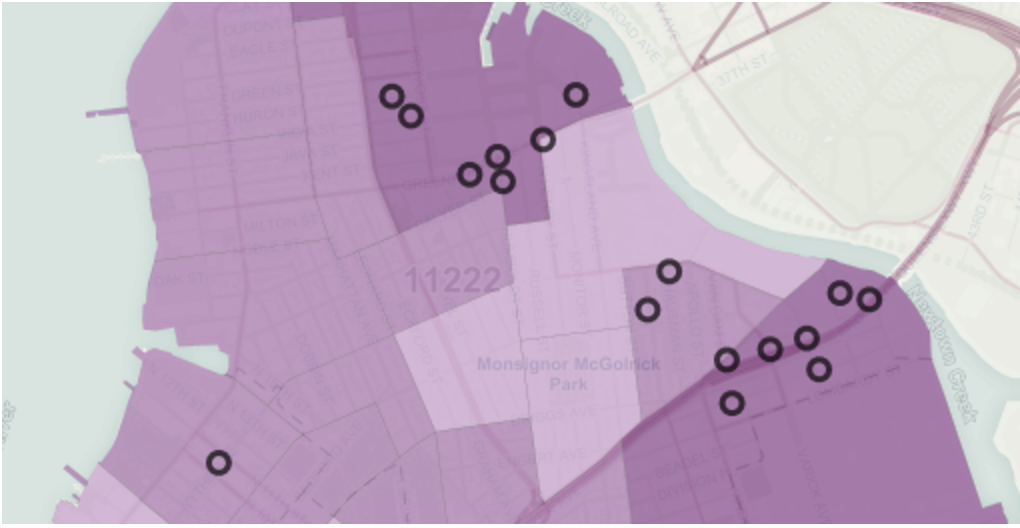How Greenpoint and North Brooklyn are fighting for cleaner air-one truck at a time
Hey Go Green family! It’s Allison here, bringing you some environmental justice scoop. My last post took us back in time through discussing industrial history in Greenpoint focusing specifically on lead contamination as a result of old paint, pipes and diesel fuel. If you missed it, check it out here!
In this article, I will be speaking about air quality and how North Brooklyn has become home to 19 waste transfer stations resulting in high number of diesel trucks and pollution. This happened when Mayor Giuliani closed the Staten Island Fresh Kills landfill in 2001 (with a brief reopening to process 9/11 debris).
Let’s start in 1947 when Fresh Kills opened as the United States first landfill. It was a new process of layering ash from incinerated waste, garbage with a topping of dirt to mask the smell. By the 1990’s Fresh Kills landfill in Staten Island consumed 2,200 acres of New York Cities waste. Maybe where Staten Island got their reputation? Just kidding we love you!
Fast forward to the early 2000’s when the landfill closed and turned into a park (three times larger than central park), thousands of pounds of waste needed to be relocated. Where will it go? With the city’s population growing, waste transfer stations became necessary to process garbage to then be shipped out of state. That’s when the overburdened, low income communities of the South Bronx, East Queens and North Brooklyn took on a new responsibility.
Let’s zoom in on North Brooklyn. According to community based research produced by the Transform Don’t Trash Coalition, North Brooklyn sees 203 trucks every hour on weekdays. Out of those 203 trucks, 30% are commercial waste trucks.
That means our area has 5X the average asthma-inducing pollutant levels due to these trucks.
The screenshot below is an image from Neighbors Allied for Good Growths ToxiCity Map showing the coalition between asthma rates (darker purple means higher asthma) and waste transfer stations (represented by black circles) in Greenpoint specifically. Each one of these stations accepts garbage from all over the city, coming on unregulated routes.

Clean Up North Brooklyn is a grassroots community organization fighting to show light on the illegal activity of these waste transfer stations and private hauling companies. Check out this video they made sharing personal stories through their study.
Activists from North Brooklyn have showed our support for the fight in the South Bronx also. Always remembering a united movement is stronger than a divided one. Read more about Inro 495A and what the South Bronx is doing to limit their influx of garbage trucks.
So what’s the solution? Just this past summer, New York City Mayor Bill de Blasio and the Department of Sanitation announced that over the next six years, New York will transition to a zoned collection system for commercial waste as a result of public pressure to conduct an unprecedented study on the inefficient hauling routes.
Under a zoned system, DSNY calculates routes will become drastically more efficient, with haulers servicing 8.7 times more businesses in the same distance as under the current system, reducing vehicle miles traveled (VMTs) by 49 to 68 percent. Zoning will also reduce the emission of air pollutants closely linked to asthma and other respiratory illnesses by between 34 and 62 percent.
– Dept of Sanitation

The image above represents the proposed zones provided by the city’s transportation consultants.
I decided to take a moment and speak directly with a Greenpoint resident to see how they felt about all this. Paul Mandel, who lives right on Manhattan ave told me most of the traffic he sees is congested with huge trucks- less trucks, less traffic. He appreciates the city working towards a zoned system and believes the zones will allow for better air quality for his community.
Greenpoint and North Brooklyn is at the forefront of this fight- working alongside the city and other affected neighbors to advocate for our right to clean air, water and soil. It’s because of the hard work done by community advocates that the city has committed to this zoned system. Sign this petition and stay updated and learn more through our city-wide organizations at: Environmental Justice Alliance and the Transform Don’t Trash Coalition.
-Allison Currier



